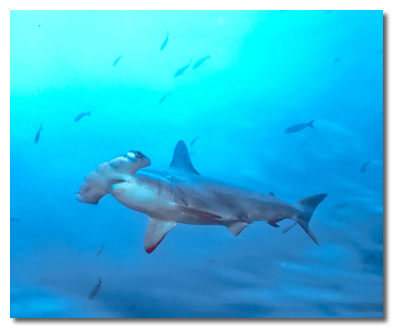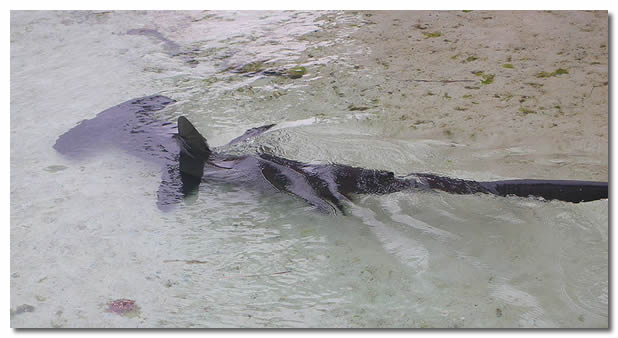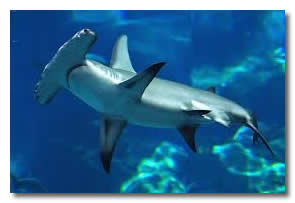Hammerhead Shark Teeth for Sale
Hammerhead sharks are some of the ocean’s most mysterious and intriguing inhabitants. Their oddly shaped head resembles something that would come out of a science fiction movie. Perhaps this is why so many people are drawn to collecting their teeth. Whatever the reason, you can find one of the largest selections of hammerhead teeth for sale listed below. Simply browse through our listings and click on the ones you are interested in to learn more.
*As a participant of the eBay Partner Network, Shark Teeth Store may earn a commission when visitors click on product links and make a purchase.
Hammerhead Shark Information

The hammerhead shark isn’t a specific species but rather a group of sharks in the family Sphyrnidae. Currently, taxonomists have identified a total of nine species in this family. All nine share some common physical characteristics and traits, the most noticeable of which is their narrow, flattened head with eyes set far apart from one another on each side (also known as cephalofoil).
Scientists believe the hammerhead’s uniquely shaped head has evolved over the course of millions of years to provide them with a full 360-degree panoramic view. With this superior level of sight, hammerheads are capable of identifying prey from afar.
In addition to their keen sight, hammerheads also have the ability (electroreception) to detect prey by reading the electrical signals from other animals in the water. Any nearby prey creating electric signals will catch the attention of a hunting hammerhead. While all sharks possess this ability, hammerheads are more adept due to the increased number of receptors in their head.
The nine known species of hammerhead sharks include:
- Great hammerhead (Sphyrna mokarran)
- Bonnethead (Sphyrna tiburo)
- Scalloped bonnethead (Sphyrna corona)
- Smalleye hammerhead (Sphyrna tudes)
- Smooth hammerhead (Sphyrna zygaena)
- Scoophead (Sphyrna media)
- Scalloped hammerhead (Sphyrna lewini)
- Winghead shark (Eusphyra blochii)
Hammerheads prefer to inhabit the warm tropical and subtropical coastal waters around the world where they can easily find prey. They remain grouped in schools during the daytime and venture out alone at night in search of prey, which is an unusual characteristic not commonly found in sharks. Hammerheads feast on a wide variety of aquatic prey, some of which includes squid, octopus, fish, shrimp, lobsters, crabs and stingray. They can pin large prey such as the stingray down on the ocean floor using their oddly shaped head.
Certain species of hammerheads, including the great hammerhead, migrate to cooler waters (both north and south) in the summer. For the most part, though, hammerheads stay around the shallow and warm coastal waters where prey is easy to find. It’s not uncommon to find younger hammerheads swimming up in shallow ocean waters less than a foot deep! Although this type of behavior can frighten beach-goers, small hammerheads such as these are typically harmless.
While scientists have learned a lot about the hammerhead, the reasoning behind the shape of their head is still debated to this day. Some scientists believe millions of years of evolution led to their uniquely-shaped head, while others believe it was a spontaneous mutation. Either way, these highly unique sharks are in a class of their own.

Fun Facts About The Hammerhead Shark
- Hammerheads frequently travel in packs, some of which may consist of 400 or more sharks (check the video below for an example).
- As the name suggests, the great hammerhead is the largest of the 9 species.
- Hammerheads possess flat bodies which allow them to swim silently on the ocean floor.
- Scientists believe their uniquely shaped heads, which contain electroreceptor sensor pores, allow them to scan the ocean more efficiently. All sharks have and use these pores to sense the electrical field of aquatic prey, but hammerheads have them spread out.
- Unlike other sharks, hammerheads only reproduce about once a year.
- Unfortunately, the scalloped hammerhead and great hammerhead are currently listed as endangered and the smalleye hammerhead is listed as vulnerable due to overfishing.
- Only three species are considered to be dangerous to humans — the scalloped, smooth and great hammerhead.
- Scientists believe the population of scalloped hammerheads has reduced by 95% within the past 30 years.
- Without their wing-shaped head, hammerheads would fall and sink to the bottom of the ocean floor.
- In Hawaiian culture, hammerheads are revered as the most respected type of shark in the ocean.
- One particular species, the bonnethead hammerhead, is capable of reproducing asexually.
- Depending on the species, hammerheads live an average of 20-30 years.
It’s important to note that only three hammerheads are considered a threat to humans — the great, smooth and scalloped hammerhead. These three species are known for their aggressive and downright violent behavior. The great hammerhead is even known to attack and feed on smaller hammerheads.
The good news is that most hammerheads are relatively small in size, with adults ranging somewhere between 10-20 feet in length. Even if you see them swimming in shallow ocean waters, they will likely continue to go about their business without paying you any mind.

About Hammerhead Shark Teeth
Want to know what a hammerhead shark tooth looks like? While there are always exceptions, most resemble a short triangle with several serrations along the edges. Some of them are fat while others are more pointy. Typically, the pointy teeth are found in the front of the shark’s jaws, while the fatter ones are found towards the rear. This principle holds true for most shark species, including hammerheads.
Because there are nine different hammerhead species, the size and shape of their teeth can vary greatly. Beginners and even experienced collectors alike may have difficulty identifying the correct species. However, great hammer teeth are larger and more prominent than other species, featuring more mass and overall serrations.
Video of Hammerhead Sharks in The Galapagos
Check out this video depicting hundreds of scalloped hammerheads gathering around the Galapagos Islands. It’s a pretty interesting documentary covering the large populations of hammerheads in the Galapagos Islands. Naturally, one might assume this gathering is due to an abundance of prey, but the truth is that no one knows why exactly hammerheads gather in the Galapagos.








